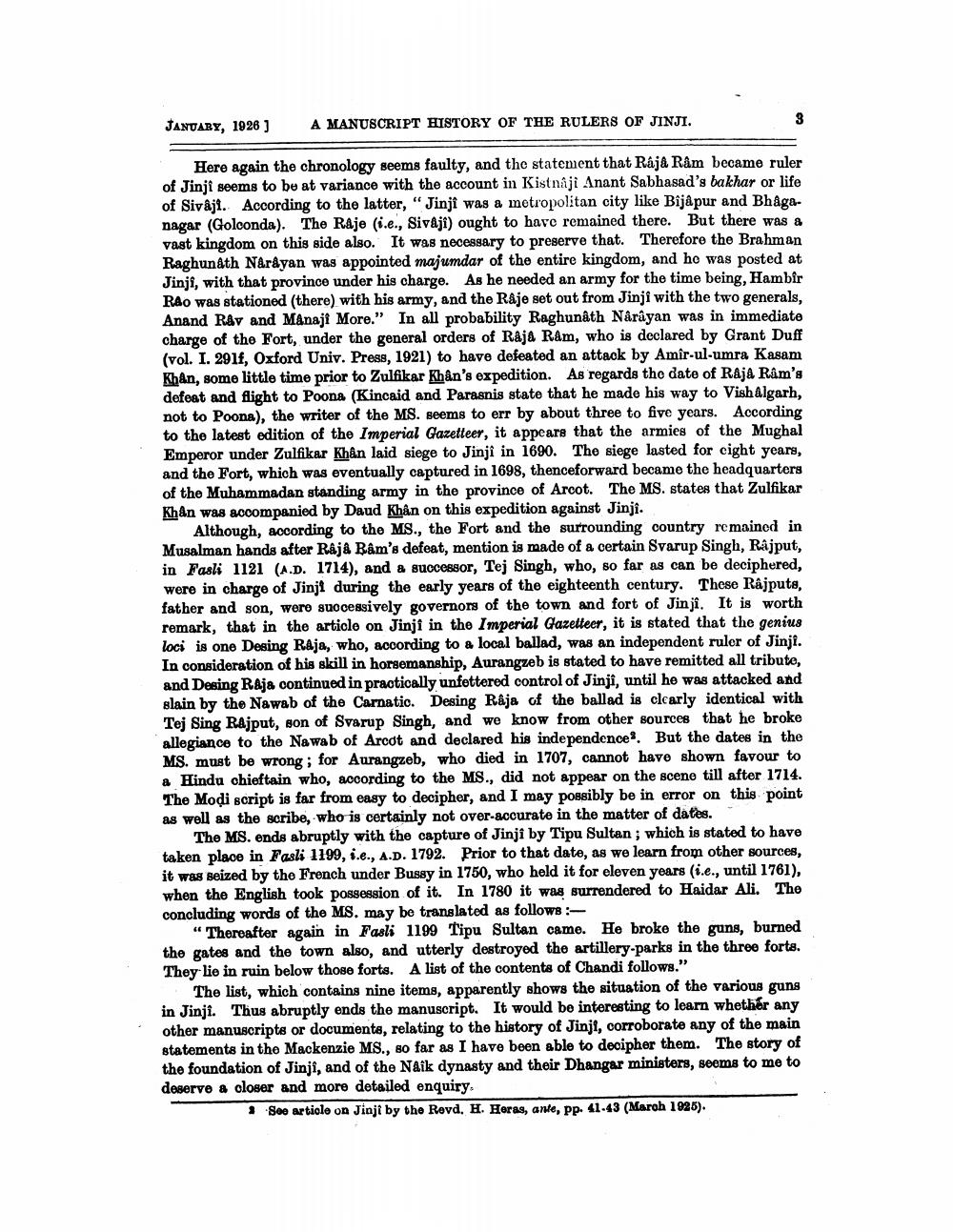Book Title: Indian Antiquary Vol 55 Author(s): Richard Carnac Temple, Stephen Meredyth Edwardes, Krishnaswami Aiyangar Publisher: Swati Publications View full book textPage 9
________________ JANUARY, 1026 A MANUSCRIPT HISTORY OF THE RULERS OF JINJI. Here again the chronology seems faulty, and the statement that Raja Râm became ruler of Jinji seems to be at variance with the account in Kistnaji Anant Sabhasad's bakhar or life of Sivaji. According to the latter, "Jinji was a metropolitan city like Bijapur and Bhaganagar (Goloonda). The Raje (i.e., Sivaji) ought to have remained there. But there was a vast kingdom on this side also. It was necessary to preserve that. Therefore the Brahman Raghunath Narayan was appointed majumdar of the entire kingdom, and he was posted at Jinji, with that province under his charge. As he needed an army for the time being, Hambir Rao was stationed (there) with his army, and the R&je set out from Jinji with the two generals, Anand Ray and Manajt More." In all probability Raghunath Narayan was in immediate charge of the Fort, under the general orders of Raja Ram, who is declared by Grant Duff (vol. I. 291f, Oxford Univ. Press, 1921) to have defeated an attack by Amir-ul-umra Kasam Khân, some little time prior to Zulfikar Khan's expedition. As regards the date of Rája Ram's defeat and flight to Poona (Kincaid and Parasnis state that he made his way to Vishalgarh, not to Poona), the writer of the MS. seems to err by about three to five years. According to the latest edition of the Imperial Gazetteer, it appears that the armies of the Mughal Emperor under Zulfikar Khân laid siege to Jinji in 1690. The siege lasted for cight years, and the Fort, which was eventually captured in 1698, thenceforward became the headquarters of the Muhammadan standing army in the province of Arcot. The MS. states that Zulfikar Khan was accompanied by Daud Khån on this expedition against Jinji. Although, according to the MS., the Fort and the surrounding country remained in Musalman hands after Raja Râm's defeat, mention is made of a certain Svarup Singh, Rajput, in Fasli 1121 (A.D. 1714), and a successor, Tej Singh, who, so far as can be deciphered, were in charge of Jinji during the early years of the eighteenth century. These Rajputs, father and son, were successively governors of the town and fort of Jinji. It is worth remark, that in the article on Jinji in the Imperial Gazetteer, it is stated that the genius loci is one Desing Raja, who, according to a local ballad, was an independent ruler of Jinji. In consideration of his skill in horsemanship, Aurangzeb is stated to have remitted all tribute and Desing Raja continued in practically unfettered control of Jinji, until he was attacked and glain by the Nawab of the Carnatio. Desing Raja of the ballad is clearly identical with Tej Sing Rajput, son of Svarup Singh, and we know from other sources that he broke allegiance to the Nawab of Arcot and declared his independence. But the dates in the MS. must be wrong; for Aurangzeb, who died in 1707, cannot have shown favour to a Hindu chieftain who, according to the MS., did not appear on the scene till after 1714. The Modi script is far from easy to decipher, and I may possibly be in error on this point as well as the scribe, who is certainly not over-accurate in the matter of dates. The MS. ends abruptly with the capture of Jinji by Tipu Sultan; which is stated to have taken place in Fasli 1199, i.e., A.D. 1792. Prior to that date, as we learn from other sources, it was seized by the French under Bussy in 1750, who held it for eleven years (i.e., until 1761), when the English took possession of it. In 1780 it was surrendered to Haidar Ali. The concluding words of the MS. may be translated as follows: “Thereafter again in Fasli 1199 Tipu Sultan came. He broke the guns, burned the gates and the town also, and utterly destroyed the artillery-parks in the three forta. They lie in ruin below those forts. A list of the contents of Chandi follows." The list, which contains nine items, apparently shows the situation of the various guns in Jinji. Thus abruptly ends the manuscript. It would be interesting to learn whether any other manuscripts or documents, relating to the history of Jinji, corroborate any of the main statements in the Mackenzie MS., so far as I have been able to decipher them. The story of the foundation of Jinji, and of the Ndik dynasty and their Dhangar ministers, seems to me to deserve a closer and more detailed enquiry See article on Jinji by the Revd. H. Heras, ante, pp. 41-43 (March 1926).Page Navigation
1 ... 7 8 9 10 11 12 13 14 15 16 17 18 19 20 21 22 23 24 25 26 27 28 29 30 31 32 33 34 35 36 37 38 39 40 41 42 43 44 45 46 47 48 49 50 51 52 53 54 55 56 57 58 59 60 61 62 63 64 65 66 67 68 69 70 71 72 73 74 75 76 77 78 79 80 81 82 83 84 85 86 87 88 89 90 91 92 ... 370
